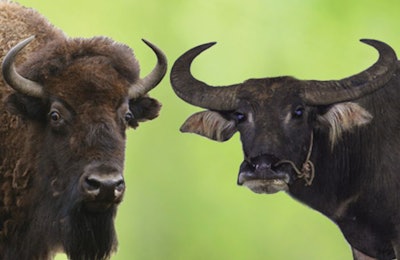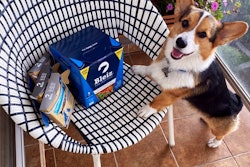
As the pet food industry strives to utilize more and different novel proteins for inclusion in dog and cat foods, "buffalo" has become a popular ingredient. However, as the market grew, it rapidly became unclear as to which species of animal a given manufacturer was referring. This opened the door to potentially misleading representations as to exactly what was in a product compared to consumer expectations, an issue which the Association of American Feed Control Officials (AAFCO) recently moved to remedy.
How does the world define “buffalo?”
From a United States perspective, mention of the word "buffalo" in a product name or ingredient list is most likely to bring visions of Bison bison, the large ungulate once numerous and widely dispersed across the North American prairies. While perhaps more accurately identified as "bison," the term "buffalo" is considered a perfectly acceptable synonym if not the much more common term for this species as evidenced by its prominent use in the American lexicon. After all, the song "Home on the Range" reads "give me a home where the buffalo roam," not “where the bison roam." It is obvious as to the intended root of the names Buffalo Bill Cody and the city of Buffalo, New York. The "buffalo nickel" (an old U.S. five-cent coin) is so named by its depiction of Bison bison on one side. Given these facts, it's likely that most U.S. consumers would reasonably expect a "buffalo"-containing pet food to be comprised of bison-derived ingredients.
Elsewhere in the world, though, a "buffalo" can be one of a number of species, arguably including the Cape buffalo from Africa but most commonly referring to the domestic water buffalo from Asia (Bubalus bubalis). In fact, it was argued that because bison are technically unrelated to buffalo taxonomically, it was false and misleading to refer to bison as such. Rather, it was asserted that the term should be rightfully limited to those species that fit the proper taxonomic classification.
AAFCO’s decision on clarification
After considerable discussion and debate that included proponents of both sides, AAFCO concluded that all uses of the term "buffalo" must be further qualified so that it is always clear to the consumer as to what is being purchased. Various means of implementing this interpretation were considered, including the promulgation of new regulations, establishment of new animal feed ingredient definitions and issuance of a new Statement of Uniform Interpretation and Policy. In the end, though, new official feed terms to distinguish the two major species were considered the most expedient and efficient means to accomplish this goal.
Under these new terms, products containing the meat or other materials (e.g., byproducts, meals) derived from Bubalus bubalis must be identified as "water buffalo" or "water buffalo ___," respectively, both in the ingredient declaration as well as in the product variety name or elsewhere on the label. On the other hand, meat or materials derived from Bison bison would need to be declared as "North American buffalo" or "North American buffalo ____," respectively. Alternatively, the word "bison" can be used in lieu of "North American buffalo."
What it means for pet food
With passage of these new feed terms, reference to just "buffalo" on a pet food label would be false and misleading. Also to be considered by manufacturers is that other means of labeling that may lead the consumer to inaccurately infer the true source of the ingredient may be objectionable to state feed control officials as well. For example, a product variety name giving an impression as to the contents without calling out the ingredient per se, such as "Prairie Formula," may falsely imply the source of the product's primary ingredients if it in fact contained water buffalo-based and not bison-based ingredients. Also, graphic depictions of bison or a landscape typical of its environment on the label may be deemed false and misleading if in fact the product did not contain bison-derived ingredients.
The Full AAFCO membership voted to approve the new feed terms at the AAFCO "mid-year" meeting in January 2020, hence the terms should appear in the next electronic version of the AAFCO Official Publication. There is no established grace period for enforcement, thus violations could be potentially actionable at any time. It's likely most states will provide for a reasonable period of time to allow for correction of labels, though those feed control officials who have seen this matter as an issue for some time may be less inclined to be patient. In any event, moving forward it is prudent for manufacturers of products containing either bison or water buffalo-derived ingredients to design all new labels in accordance with the new requirements.
Briefly: Top 5 takeaways
- In the U.S., “buffalo” can be used to refer to bison. In other countries, however, the term usually refers to water buffalo.
- AAFCO has concluded that all uses of the term "buffalo" must be further qualified to avoid consumer confusion.
- New requirements differentiate between “water buffalo” and “North American buffalo” (or “bison).
- The new feed terms were approved at AAFCO’s mid-year meeting in January 2020, hence are currently actionable.
- New labels meeting the new requirements should be designed in order to remain in compliance.
















